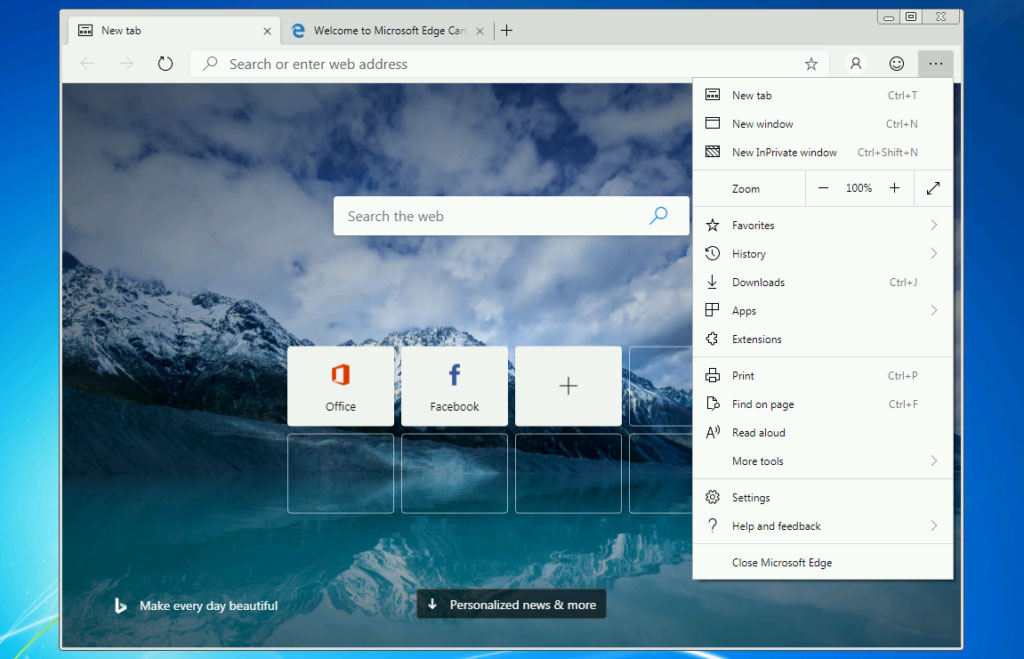Microsoft's retooled Edge browser is now available on Windows 7 and 8
The Chromium-based Edge previewed has expanded to older OSes.

After several months of testing on Windows 10, Microsoft has now made available its reworked Edge browser in preview form to Windows 7 and Windows 8/8.1 users as well.
Edge is Microsoft's home grown browser for Windows 10, just as Internet Explorer was for previous versions of Windows. Back in December, however, Microsoft made the surprise announcement that it was gutting Edge and rebuilding it around Google's open source Chromium platform, which is what the Chrome browser is based on.
Opera Software made the same decision in 2013 for its Opera browser, swapping out its own propriety Presto layout engine for Blink (based on Chromium). Likewise, Microsoft originally built its Edge browser around its own EdgeHTML layout and Chakra JavaScript engines, but is migrating to Blink and V8, both of which are Chromium engines.
Microsoft previously said that the major under-the-hood retooling would take place "over the next year or so" rather than overnight. That was in December. In April, Microsoft started previewing its reworked Edge browser to Windows 10, and now Windows 7 and Windows 8/8.1 users can take it for a test drive as well.
"Delivering the next version of Microsoft Edge to all supported versions of Windows is part of our goal to improve the web browsing experience for our customers on every device, and to empower developers to build great experiences with less fragmentation. Microsoft Edge will have the same always up-to-date platform and the same developer tools on all supported versions of Windows and macOS. This will reduce developer pain on the web, while ensuring all Windows customers have the latest browsing option," Microsoft stated in a blog post.
Since this is an early "Canary" build, there are some known issues, and you can probably expect some unknown hiccups. It's also missing some features, such as dark mode support.
Edge comes with its own selection of extensions through the Microsoft Store, but there's also a toggle to allow extensions from "other stores" (i.e., Chrome Store). In my limited testing with Edge (in Windows 10), it felt fast and fairly functional for being such an early build. I imagine the same will be true on Windows 7 and Windows 8/8.1.
Keep up to date with the most important stories and the best deals, as picked by the PC Gamer team.
Microsoft's decision to ditch its own layout and JavaScript engines is not without criticism. Mozilla, the developer behind Firefox, took particular exception to Microsoft's move to Chromium. Mozilla stated in a blog post that though Microsoft's decision makes sense from a business point of view, it has the side effect of further empowering Google.
"From a social, civic and individual empowerment perspective ceding control of fundamental online infrastructure to a single company is terrible. This is why Mozilla exists. We compete with Google not because it’s a good business opportunity. We compete with Google because the health of the internet and online life depend on competition and choice. They depend on consumers being able to decide we want something better and to take action," Mozilla wrote.
From Microsoft's vantage point, embracing Chromium will lead to better compatibility on the web across multiple devices.
Follow this link to test drive Edge.
Paul has been playing PC games and raking his knuckles on computer hardware since the Commodore 64. He does not have any tattoos, but thinks it would be cool to get one that reads LOAD"*",8,1. In his off time, he rides motorcycles and wrestles alligators (only one of those is true).


